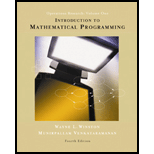
Introduction to mathematical programming
4th Edition
ISBN: 9780534359645
Author: Jeffrey B. Goldberg
Publisher: Cengage Learning
expand_more
expand_more
format_list_bulleted
Concept explainers
Expert Solution & Answer
Chapter 4.7, Problem 8P
a.
Explanation of Solution
Linear program that is optimal
- The only way to pivot in a new basic variable and still keep z at its optimal value would be to pivot in x3...
b.
Explanation of Solution
Optimal solutions in LP
- Since x3 has a 0 coefficient in row 0, it can be increased and still keep z at its same value...
Expert Solution & Answer
Want to see the full answer?
Check out a sample textbook solution
Students have asked these similar questions
Consider the following LP and its optimal tableau:
max z = 3x1 + 2x2s.t. 2x1 + 5x2 ≤ 8 3x1 + 7x2 ≤ 10 x1, x2 ≥ 0
a) Find the dual of this LP and its optimal solution.
b) Find the range of values of b2 for which the current basis remains optimal. Also find the new optimal solution if b2 = 5.
Suppose the risk index for the stock fund (the value of ) increases from its current value of 8 to 12. How does the optimal solution change, if at all?
Suppose the risk index for the money market fund (the value of ) increases from its current value of 3 to 3.5. How does the optimal solution change, if at all?
Suppose increases to 12 and increases to 3.5. How does the optimal solution change, if at all?
A pig weighting 200 pounds gains 5 pounds per day and costs 45 cents aday to keep. The market price for pigs is 65 cents per pound, but is falling 1 cent perday.a/ When should the pig be sold? What is the optimal profit?b/ What are the sensitivities of the optimal time and optimal profit with respect to the45-cent upcost?c/ What are the sensitivities of the optimal time and optimal profit with respect to the1-cent market depreciation?
Chapter 4 Solutions
Introduction to mathematical programming
Ch. 4.1 - Prob. 1PCh. 4.1 - Prob. 2PCh. 4.1 - Prob. 3PCh. 4.4 - Prob. 1PCh. 4.4 - Prob. 2PCh. 4.4 - Prob. 3PCh. 4.4 - Prob. 4PCh. 4.4 - Prob. 5PCh. 4.4 - Prob. 6PCh. 4.4 - Prob. 7P
Ch. 4.5 - Prob. 1PCh. 4.5 - Prob. 2PCh. 4.5 - Prob. 3PCh. 4.5 - Prob. 4PCh. 4.5 - Prob. 5PCh. 4.5 - Prob. 6PCh. 4.5 - Prob. 7PCh. 4.6 - Prob. 1PCh. 4.6 - Prob. 2PCh. 4.6 - Prob. 3PCh. 4.6 - Prob. 4PCh. 4.7 - Prob. 1PCh. 4.7 - Prob. 2PCh. 4.7 - Prob. 3PCh. 4.7 - Prob. 4PCh. 4.7 - Prob. 5PCh. 4.7 - Prob. 6PCh. 4.7 - Prob. 7PCh. 4.7 - Prob. 8PCh. 4.7 - Prob. 9PCh. 4.8 - Prob. 1PCh. 4.8 - Prob. 2PCh. 4.8 - Prob. 3PCh. 4.8 - Prob. 4PCh. 4.8 - Prob. 5PCh. 4.8 - Prob. 6PCh. 4.10 - Prob. 1PCh. 4.10 - Prob. 2PCh. 4.10 - Prob. 3PCh. 4.10 - Prob. 4PCh. 4.10 - Prob. 5PCh. 4.11 - Prob. 1PCh. 4.11 - Prob. 2PCh. 4.11 - Prob. 3PCh. 4.11 - Prob. 4PCh. 4.11 - Prob. 5PCh. 4.11 - Prob. 6PCh. 4.12 - Prob. 1PCh. 4.12 - Prob. 2PCh. 4.12 - Prob. 3PCh. 4.12 - Prob. 4PCh. 4.12 - Prob. 5PCh. 4.12 - Prob. 6PCh. 4.13 - Prob. 2PCh. 4.14 - Prob. 1PCh. 4.14 - Prob. 2PCh. 4.14 - Prob. 3PCh. 4.14 - Prob. 4PCh. 4.14 - Prob. 5PCh. 4.14 - Prob. 6PCh. 4.14 - Prob. 7PCh. 4.16 - Prob. 1PCh. 4.16 - Prob. 2PCh. 4.16 - Prob. 3PCh. 4.16 - Prob. 5PCh. 4.16 - Prob. 7PCh. 4.16 - Prob. 8PCh. 4.16 - Prob. 9PCh. 4.16 - Prob. 10PCh. 4.16 - Prob. 11PCh. 4.16 - Prob. 12PCh. 4.16 - Prob. 13PCh. 4.16 - Prob. 14PCh. 4.17 - Prob. 1PCh. 4.17 - Prob. 2PCh. 4.17 - Prob. 3PCh. 4.17 - Prob. 4PCh. 4.17 - Prob. 5PCh. 4.17 - Prob. 7PCh. 4.17 - Prob. 8PCh. 4 - Prob. 1RPCh. 4 - Prob. 2RPCh. 4 - Prob. 3RPCh. 4 - Prob. 4RPCh. 4 - Prob. 5RPCh. 4 - Prob. 6RPCh. 4 - Prob. 7RPCh. 4 - Prob. 8RPCh. 4 - Prob. 9RPCh. 4 - Prob. 10RPCh. 4 - Prob. 12RPCh. 4 - Prob. 13RPCh. 4 - Prob. 14RPCh. 4 - Prob. 16RPCh. 4 - Prob. 17RPCh. 4 - Prob. 18RPCh. 4 - Prob. 19RPCh. 4 - Prob. 20RPCh. 4 - Prob. 21RPCh. 4 - Prob. 22RPCh. 4 - Prob. 23RPCh. 4 - Prob. 24RPCh. 4 - Prob. 26RPCh. 4 - Prob. 27RPCh. 4 - Prob. 28RP
Knowledge Booster
Learn more about
Need a deep-dive on the concept behind this application? Look no further. Learn more about this topic, computer-science and related others by exploring similar questions and additional content below.Recommended textbooks for you
 Operations Research : Applications and AlgorithmsComputer ScienceISBN:9780534380588Author:Wayne L. WinstonPublisher:Brooks Cole
Operations Research : Applications and AlgorithmsComputer ScienceISBN:9780534380588Author:Wayne L. WinstonPublisher:Brooks Cole

Operations Research : Applications and Algorithms
Computer Science
ISBN:9780534380588
Author:Wayne L. Winston
Publisher:Brooks Cole